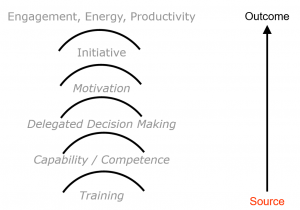
In my experience, the term “employee engagement” is still not recognised or embraced in the owner managed / private enterprise sector.
I consistently meet business owners who are frustrated that they “have to do it all” i.e. they aren’t getting more from their employees and seem perplexed as to why this might be. In addition, business owners instinctively recognise that they are not as efficient as they should be in their processes (especially in the service sector) and are frustrated by bottle-necks and wasted time, which reflects badly in the P&L in reduced profits, in addition to disheartened, disengaged staff. Business growth is hampered or stalled completely.
Cutting to the chase, here is the answer, uncovered in my recent conversation with one of those frustrated entrepreneurs:
“If you accept engaged, productive and energetic employees untimately provide a commercially & culturally sustainable business, ask yourself what do engaged employees look like – what behaviours do they demonstrate?”
“well….they show initiative”
“which comes from…….”
“feeling motivated to do so”
“Okay – to feel motivated and feel safe to use their own initiative what freedoms do they need to have?”
“I guess we need to give them some responsibility?”
“Great – specifically what does that look like?”
“Let them make their own decisions”
“Good – what stops you letting them make their own decisions”
“I’m not confident that they have the capability or technical competence to do so”
“Yup, I can understand that……..what would give you comfort that they are capable and competent?”
“Identify their training needs”
“Absolutely – training provides competency, which gives you the confidence to divest some decision making, which in itself is very motivating to your employees, encouraging them to use their initiative, which creates engagement – when employees are engaged their levels of discretionary effort, productivity & energy increase which impacts positively on your bottom line and your employees emotional attachment to your company”.
For a number of years, Brian Butler of Accelerate Ltd and I have been working with service sector companies, through the SE Business Improvement Academy, and are still blown away with the productivity benefits (both commercial and cultural) they uncover for their organisations, through their chosen projects. Hats off to their leaders who have recognised that by committing their staff to this particular training programme, not only leads to clear and measurable organisational & personal benefits, but boosts engagement considerably.
In my experience, I still see too many businesses classifying training as a cost and not recognising training as an investment. Perhaps by taking a wider view (as shown in the diagram above), owners can see investing in the right kind of training builds employees first, who can then build the business.